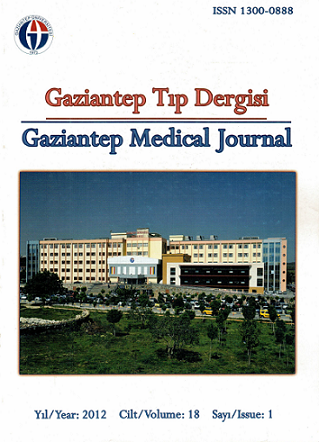The role of electroencephalogram in childhood neurological disorders
Çocukluk çağı nörolojik bozukluklarda elektroensefalogramın rolü
DOI:
https://doi.org/10.5455/GMJ-30-2011-56Keywords:
Electroencephalography, epilepsy, paroxysmal eventAbstract
The aim of this study was to obtain a baseline for clinical application of electroencephalography (EEG) in children and to evaluate the EEG findings in children with various acute and chronic central nervous system disorders and nonepileptic events. EEG records of 250 patients were studied in Neurophysiology Departments of Queen Rania Al-Abdullah Hospital for Children in Jordan. For each patient who had undergone EEG the following data were recorded: age, sex, source of referral (inpatient or outpatient department), reason for EEG, diagnostic impressions, clinical presentation, the result of the EEG examinations and clinical correlation between the seizure type and EEG finding. Males (55%) were slightly outnumbered than females. The majority of cases were between 6-12 years. Total of 63.2% of all referrals for EEG were from outpatient clinics while inpatients accounted for 36.8% of referred cases, with Pediatric Neurology Department referrals being the highest (28.8%). Majority of diagnosis at referral were suspected epilepsy (80%) with epileptiform EEG abnormalities in 32%. Over all 64% the EEG records were normal, including all EEG records of children with syncope and headache. We conclude that there are many unnecessary routine EEG recordings in children. Investigation of epilepsy and acute encephalopathies appear to be the most valuable indications for routine pediatric EEG. EEG can be helpful in classification of seizures. Finding a way to reduce EEG requests is recommended.
Metrics
References
Goldensohn E. Historical perspectives and future directions. In: Wyllie E. The Treatment of Epilepsy. Baltimore: Williams and Williams, 1997:191-203.
Saunders M G, Westmoreland BF. The EEG evaluation of disorders affecting the brain diffusely. In: Current Practice of Clinical Electroencephalography (Eds. D. W. Klass, D. D. Day). New York, Raven Press, 1997:370-1.
Sundaram M, Sadler RM, Young GB, Pillay N. EEG in epilepsy: current perspectives. Can J Neurol Sci 1999;26(4):255-62.
Barron T. The child with spells. Pediatr Clin North Am 1991;38(3):711-24.
Wyllie E, Friedman D, Lüders H, Morris H, Rothner D, Turnbull J. Outcome of psychogenic seizures in children and adolescents compared to adults. Neurology 1991;41(5):742-4.
Blume WT, Kaibara M. Role of the electroencephalogram in some pediatric neurological problems. In: Atlas of Pediatric Electroencephalography (Eds. WT Blume, M Kaibara). Philadelphia, Lippincott Raven, 1999:361-71.
Donat JF, Wright FS. Episodic symptoms mistaken for seizures in the neurologically impaired child. Neurology 1990;40(1):156-7.
Metrick ME, Ritter FJ, Gates JR, Jacobs MP, Skare SS, Loewenson RB. Nonepileptic events in childhood. Epilepsia 1991;32(3):322-8.
Nicolaides P, Appleton RE, Beirne M. EEG requests in paediatrics: an audit. Arch Dis Child 1995;72(6):522-3.
Noachtar S, Binnie C, Ebersole J, Mauguière F, Sakamoto A, Westmoreland B. A glossary of terms most commonly used by clinical electroencephalographers and proposal for the report form for the EEG findings. The International Federation of Clinical Neurophysiology. Electroencephalogr Clin Neurophysiol Suppl 1999;52:21-41.
Falope ZF, Ogunniyi A, Osuntokun BO. Factors associated with epileptiform EEG patterns in Nigerian epileptics. East Afr Med J 1993;70(5):294-6.
Marsan CA, Zivin LS. Factors related to the occurrence of typical paroxysmal abnormalities in the EEG records of epileptic patients. Epilepsia 1970;11(4):361-81.
Binnie CD, Prior PF. Electroencephalography. J Neurol Neurosurg Psychiatry 1994;57(11):1308-19.
Airoldi L, Beghi E, Bogliun G, Crespi V, Frattola L. Rational use of EEG in adults in clinical practice. J Clin Neurophysiol 1999;16(5):456-61.
Petersen I, Eeg-Olofsson O, Sellden U. Paroxysmal activity in EEG of normal children. In: Kellaway P, Petersen I, eds. Clinical Electroencephalography of Children. New York: Grune & Stratton; 1968:167-88.
Camfield P, Gordon K, Camfield C, Tibbles J, Dooley J, Smith B. EEG results are rarely the same if repeated within six months in childhood epilepsy. Can J Neurol Sci 1995;22(4):297-300.
Niedermeyer E. The Normal EEG of the Waking Adult. In: Niedermeyer E, Lopes da Silva FH (eds.), Electroencephalography: Basic Principles, Clinical Applications and Related Fields. Lippincott Williams & Wilkins, Baltimore, 1999:149-73.
Marsan CA, Zivin LS. Factors related to the occurrence of typical paroxysmal abnormalities in the EEG records of epileptic patients. Epilepsia 1970;11(4):361-81.
Binnie CD. Epilepsy in adults: diagnostic EEG investigation. In: Kimura J, Shibasaki H, eds. Recent advances in clinical neuro-physiology. Amsterdam, Elsevier, 1996:217-22.
Fowle AJ, Binnie CD. Uses and abuses of the EEG in epilepsy. Epilepsia 2000;41(Suppl 3):S10-8.
Dalby MA. Epilepsy and three per second spike and wave rhythms. A clinical, electroencephalographic and prognostic analysis of 346 patients. Acta Neurol Scand 1969;45 (Suppl 40):1-180.
Small JG. Psychiatric disorders and EEG, in: Electroencephalography: Basic Principles, Clinical Applications, and Related Fields, edited by Niedermeyer E, Lopes Da Silva F. Baltimore, Williams and Wilkins, 1993;581- 96.
Phillips BB, Drake ME Jr, Hietter SA, Andrews JE, Bogner JE. Electroencephalography in childhood conduct and behavior disorders. Clin Electroencephalogr 1993;24(1):25-30.
Williams J, Schulz EG, Griebel ML. Seizure occurrence in children diagnosed with ADHD. Clin Pediatr (Phila). 2001;40(4):221-4.
Downloads
Published
How to Cite
Issue
Section
License
Copyright (c) 2023 European Journal of Therapeutics

This work is licensed under a Creative Commons Attribution-NonCommercial 4.0 International License.
The content of this journal is licensed under a Creative Commons Attribution-NonCommercial 4.0 International License.


















